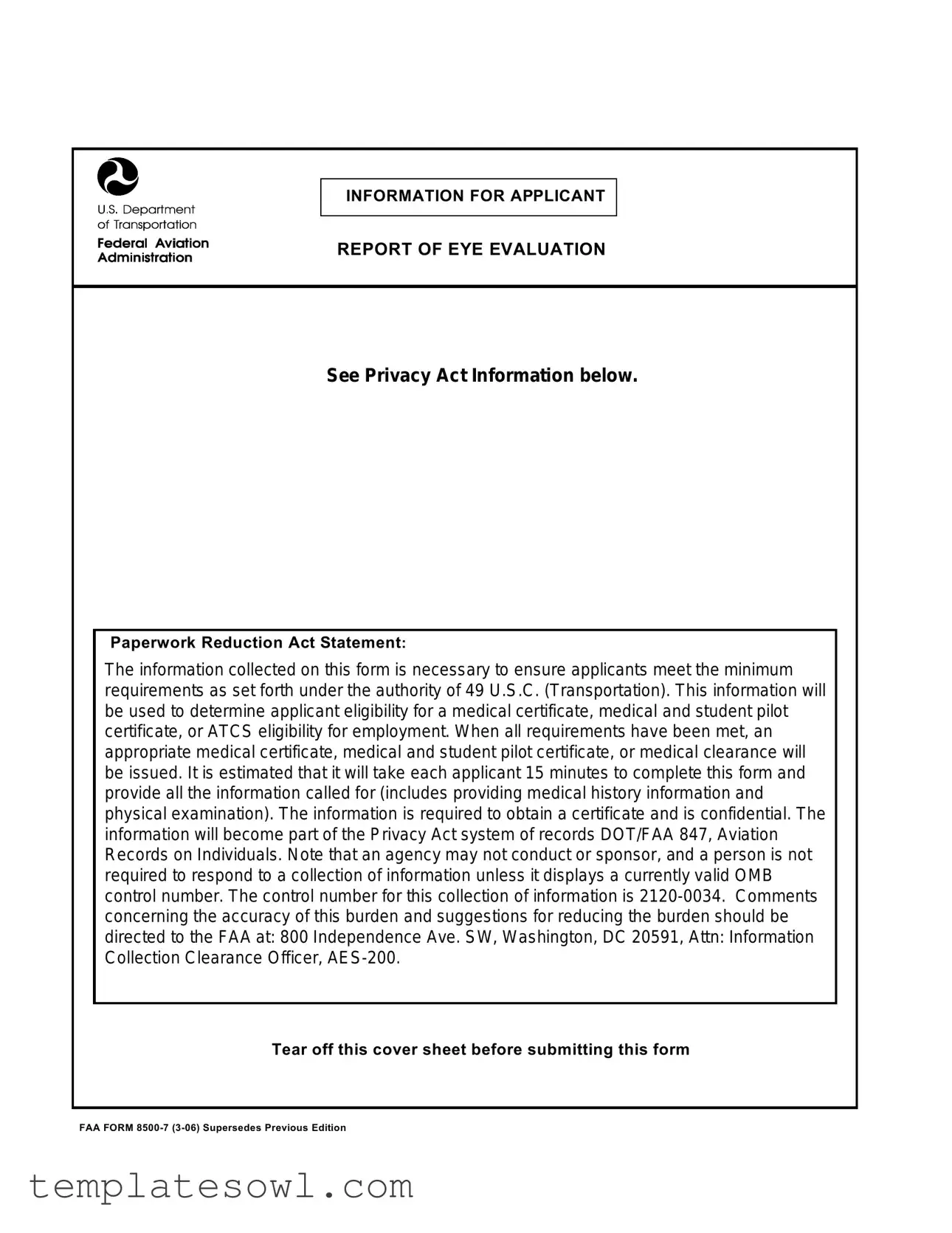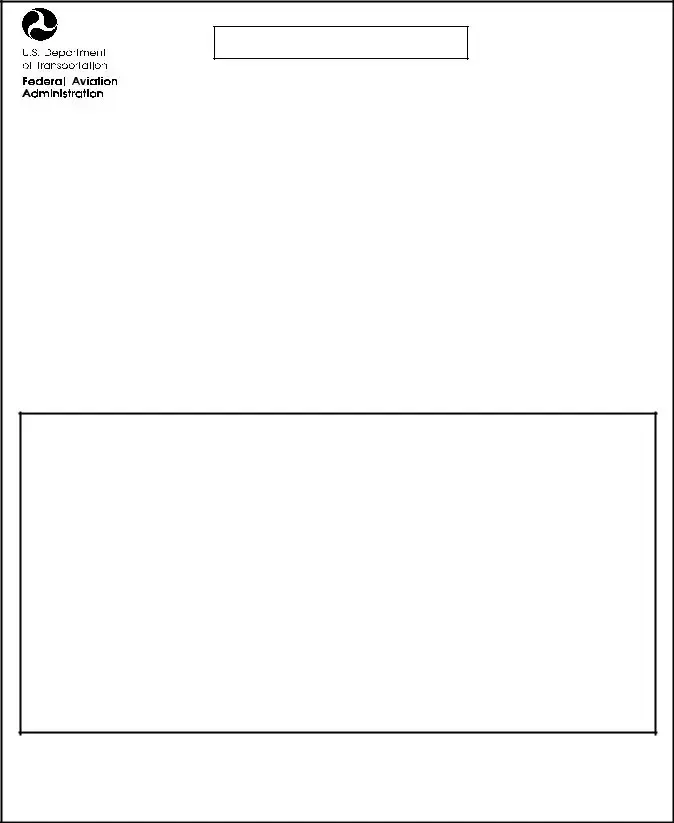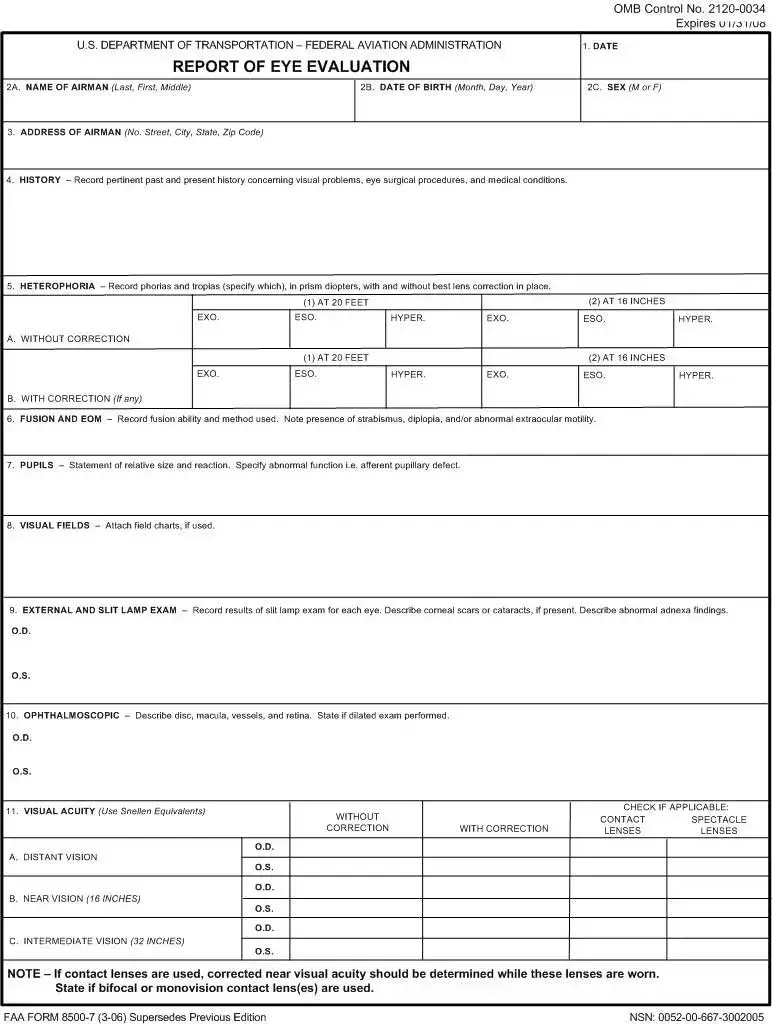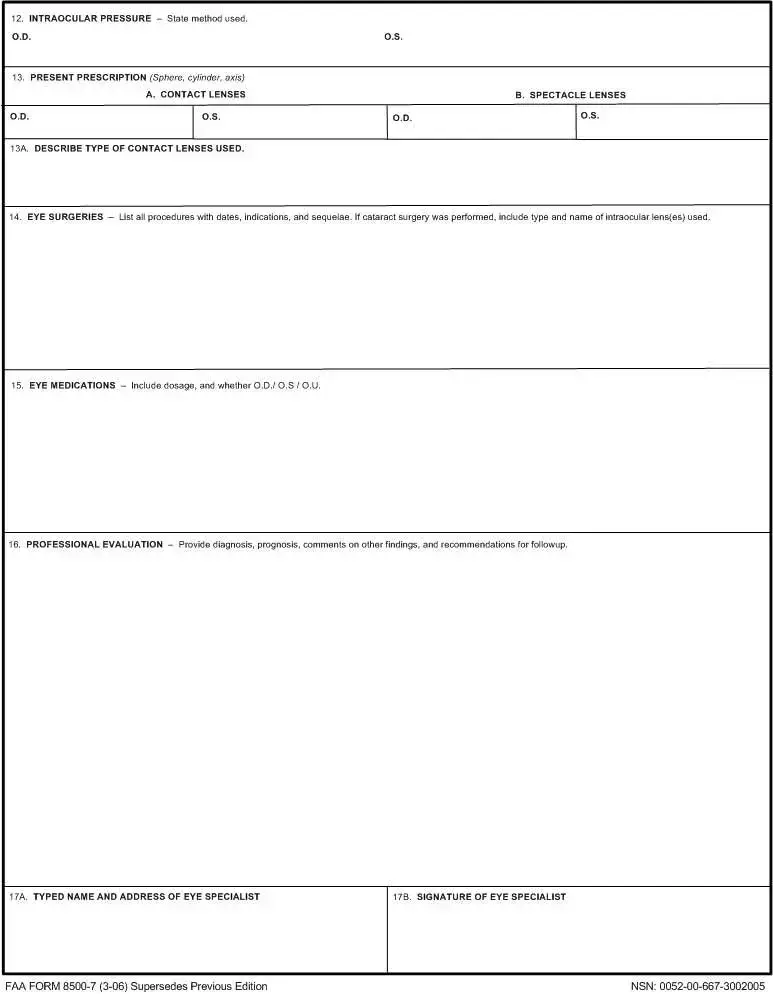INFORMATION FOR APPLICANT
REPORT OF EYE EVALUATION
See Privacy Act Information below.
Paperwork Reduction Act Statement:
The information collected on this form is necessary to ensure applicants meet the minimum requirements as set forth under the authority of 49 U.S.C. (Transportation). This information will be used to determine applicant eligibility for a medical certificate, medical and student pilot certificate, or ATCS eligibility for employment. When all requirements have been met, an appropriate medical certificate, medical and student pilot certificate, or medical clearance will be issued. It is estimated that it will take each applicant 15 minutes to complete this form and provide all the information called for (includes providing medical history information and physical examination). The information is required to obtain a certificate and is confidential. The information will become part of the Privacy Act system of records DOT/FAA 847, Aviation Records on Individuals. Note that an agency may not conduct or sponsor, and a person is not required to respond to a collection of information unless it displays a currently valid OMB control number. The control number for this collection of information is 2120-0034. Comments concerning the accuracy of this burden and suggestions for reducing the burden should be directed to the FAA at: 800 Independence Ave. SW, Washington, DC 20591, Attn: Information Collection Clearance Officer, AES-200.
Tear off this cover sheet before submitting this form
FAA FORM 8500-7 (3-06) Supersedes Previous Edition
REPORT OF EYE EVALUATION
PRIVACY ACT STATEMENT: This statement is provided pursuant to the Privacy Act of 1974, 5 USC § 552a:
The authority for collecting this information is contained in 49 U.S.C. §§ 40113, 44702, 44703, 44709 and 14 C.F.R. Part 6 7. The principal purpose for which the information is intended to be used is to identify and evaluate your qualifications and eligibility for the issuance of an airman certificate and/or rating. Submission of the data is mandatory, except for the Social Security Number, which is voluntary. Failure to provide all required information will result in our being unable to issue you a certificate and/or rating. The information collected on this form will be included in a Privacy Act System of Records known as DOT/FAA 847, titled “Aviation Records on Individuals” and will be subject to the routine uses published in the System of Records Notice (SORN) for DOT/FAA 847 (see www.dot.gov/privacy/privacyactnotices), including:
(a)Providing basic airmen certification and qualification information to the public upon request; examples of basic information include:
•The type of certificates and ratings held, limitations, date of issuance and certificate number;
•The status of the airman’s certificate (i.e., whether it is current or has been amended, modified, suspended or revoked for any reason);
•The airman’s home address, unless requested by the airman to be withheld from public disclosure per 49 U.S.C. 44703(c);
•Information relating to an airman’s physical status or condition used to determine statistically the validity of FAA
medical standards; and the date, class, and restrictions of the latest physical
•Information relating to an individual’s eligibility for medical certification, requests for special issuance, and requests for review of certificate denials. (b) Using contact information to inform airmen of meetings and seminars conducted by the FAA regarding aviation safety.
(c) Disclosing information to the National Transportation Safety Board (NTSB) in connection with its investigation responsibilities.
(d) Providing information about airmen to Federal, State, local and tribal law enforcement agencies when engaged in an official investigation in which an airman is involved. (e) Providing information about enforcement actions, or orders issued thereunder, to Federal agencies, the aviation industry, and the public upon request.
(f) Making records of delinquent civil penalties owed to the FAA available to the U.S. Department of the Treasury and the U.S. Department of Justice (DOJ) for collection pursuant to 31 U.S.C. 3711(g).
(g) Making records of effective orders against the certificates of airmen available to their employers if the airmen use the affected certificates to perform job responsibilities for those employers.
(h) Making airmen records available to users of FAA’s Safety Performance Analysis System (SPAS), including the Department of Defense Commercial Airlift Division’s Air Carrier Analysis Support System (ACAS) for its use in identifying safety hazards and risk areas, targeting inspection efforts for certificate holders of greatest risk, and monitoring the effectiveness of targeted oversight actions.
(i) Making records of an individual’s positive drug test result, alcohol test result of 0.04 or greater breath alcohol concentration, or refusal to submit to testing required under a DOT-required testing program, available to third parties, including current and prospective employers of such individuals. Such records also contain the names and titles of individuals who, in their commercial capacity, administer the drug and alcohol testing programs of aviation entities.
(j) Providing information about airmen through the Civil Aviation Registry’s Comprehensive Airmen Information System to the Department of Health and Human Services, Office of Child Support Enforcement, and the Federal Parent Locator Service that locates noncustodial parents who owe child support. Records in this system are used to identify airmen to the child support agencies nationwide in enforcing child support obligations, establishing paternity, establishing and modifying support orders and location of obligors. Records listed within the section on Categories of Records are retrieved using Connect: Direct through the Social Security Administration’s secure environment.
(k) Making personally identifiable information about airmen available to other Federal agencies for the purpose of verifying the accuracy and completeness of medical information provided to FAA in connection with applications for airmen medical certification.
(l) Making records of past airman medical certification history data available to Aviation Medical Examiners (AMEs) on a routine basis so that AMEs may render the best medical certification decision.
(m) Making airman, aircraft and operator record elements available to users of FAA’s Skywatch system, including the Department of Defense (DoD), the Department of Homeland Security (DHS), DOJ and other authorized Federal agencies, for their use in managing, tracking and reporting aviation-related security events.
(n) Other possible routine uses published in the Federal Register (see Prefatory Statement of General Routine Uses for additional uses (65 F.R. 19477-78) For example, a record from this system of records may be disclosed to the United States Coast Guard (Coast Guard) and to the Transportation Security Administration (TSA) if information from this system was shared with either agency when that agency was a component of the Department of Transportation (DOT) before its transfer to DHS and such disclosure is necessary to accomplish a DOT, TSA or Coast Guard function related to this system of records.
FAA FORM 8500-7 (3-06) Supersedes Previous Edition




